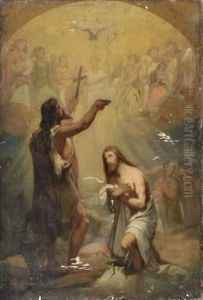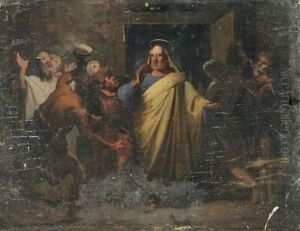Charles Alexandre Crauk Paintings
Charles Alexandre Crauk was a French sculptor born on September 16, 1819, in Valenciennes, a city notable for its rich artistic heritage. Crauk's career spanned much of the 19th century, a period marked by significant political, social, and artistic transformations in France. He died on April 10, 1905, in Paris, leaving behind a legacy of work that exemplified the Romantic and later, realist tendencies of his era.
Crauk's education in art began in his hometown, but it was in Paris, at the École des Beaux-Arts, where he truly honed his craft under the guidance of prominent sculptors such as David d'Angers and François Rude. These influences were pivotal in shaping Crauk's early style, which was characterized by a blend of classical idealism and a keen observation of reality, attributes that were highly esteemed in the academic circles of the time.
Throughout his career, Crauk received several commissions for public monuments and sculptures, many of which reflect the patriotic fervor and historical consciousness of 19th-century France. Notably, his works often featured allegorical themes and were marked by a meticulous attention to detail and a profound sense of naturalism. This was in line with the prevailing artistic movements of the time, which oscillated between Romanticism, characterized by its emphasis on emotion and individualism, and Realism, with its focus on depicting contemporary life and society without idealization.
Crauk's contributions to French sculpture were recognized with numerous awards and honors, including medals at the Paris Salon, the prestigious annual art exhibition in France. He was also made a Knight of the Legion of Honor, an accolade that attested to his esteemed position within the French art world. Despite his success, Crauk remained deeply committed to his craft, exploring various materials and techniques throughout his life.
One of his most celebrated works is the monument to General Faidherbe in Lille, which showcases Crauk's skill in creating dynamic compositions that convey both strength and emotion. His ability to imbue inanimate bronze and stone with life and vitality is a testament to his mastery of the sculptural form.
Charles Alexandre Crauk's death in 1905 marked the end of an era in French sculpture. His body of work remains a significant part of France's cultural heritage, reflecting the artistic and societal currents of his time. Through his sculptures, Crauk not only captured the spirit of the 19th century but also laid the groundwork for future generations of artists. His legacy is preserved in museums and public spaces across France, where his sculptures continue to inspire admiration and awe.



